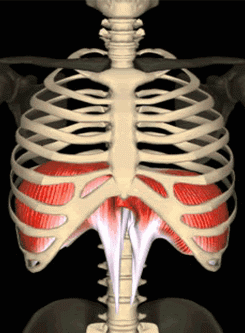BREATH TRAINING
On average, the human body takes a breath 12-15 times per minute. That’s about 22,000 breaths per day.
When we do intense exercises for an extended period of time, our body’s systems demand us to work harder to supply energy and eliminate waste products for working muscles. We can do that efficiently by utilizing the correct musculature to improve our oxygen consumption. The breathing mechanics can influence postural change and balance the efficiency of our systems.
It’s simple, the harder we work, the easier and more efficient we must breathe.
Having said that, we have to consider that the breathing muscles can get tired and need to be trained like any other muscle in our body.
To begin with, let’s understand the muscles we need to train.
1. The main muscle involved in breathing in (inhale-inspiration) is the DIAPHRAGM. It’s involved in stabilizing the torso and even though it works subconsciously, we can still improve its performance. Its ability to function is in relation to how it sits in the torso.
It’s always 3-Dimensional, an expansion that encircles the lower ribs. In fact, there should be an actual spreading of the ribs which creates and intra-abdominal pressure sideways and downward when we breathe in.
2. The INTERCOSTAL muscles surrounding the rib cage and located in the spaces between adjacent ribs are also involved in the inhale facet. They prevent soft tissue from getting sucked between the ribs during the breathing. As we inhale we should be able to feel actual space through the sideways spreading of the ribs.
3. We also involve the SCALENE and STERNOCLEIDOMASTOID muscles in the neck and rib cage. They keep the rib cage from collapsing forward, they are primary stabilizes that hold the rib cage vertical and help the head stay in a better and healthier position.
Scalene Mucles
Sternocleidomastoid Muscle
4. The PECTORALS, LATISSIMUS DORSI and SERRATUS ANTERIOR muscles in the chest and side of the ribs. The main role of this muscles during the inhale facet is helping the diaphragm when breathing demands increase during exertion (effort part of breathing).
Latissimus Dorsi Muscle
Pectoralis Muscle
Serratus Muscle
While both the muscles involved in inhaling (inspirations) and exhaling (expiration) can get fatigued and tired when working out, studies have shown respiratory-muscle-fatigue is more common during the inhale facet of breathing because we lack the ability to breath with the diaphragm laterally and end up breathing north and south- up and down chest and shoulder breathing.
On the other hand, better breathing can affect our total health without having to think about it in our daily conscious basis. The lateral torso mechanism needs to engage, so 50% of our breathing can improve and it will happen with proper alignment. An improved posture joint position and breathing mechanisms lead to a more functional life, where “you can do stuff that you could not do and want to keep doing”.
We need to give the lungs the freedom to expand and move. We need to change the thoracic angle and cervical spine position to more vertical in order to allow a more useful diaphragmatic function.
Let’s center out attention from training harder to training smarter simply by breathing better.
The breathing we are talking about is called East-West Breathing, in which the lower rib cage and lower back expand horizontally upon taking a breath. The diaphragm contracts and descends into the abdominal area of the body, allowing for a deeper breath that fills the lower lobes of your lungs with needed oxygen.
To quickly test this movement yourself, place your thumbs on the kidney area of your lower back and your index fingers on your side abdominal muscles, just below your lowest rib. As you breathe in, your fingers and thumbs should feel as if they are being pushed outward. If they are being drawn in (your chest is moving North-South), you are NOT stabilizing your torso due to postural compensations.
The easiest way to train your breathing capacity is by doing the following 5 corrective exercises from the Egoscue Method:


















